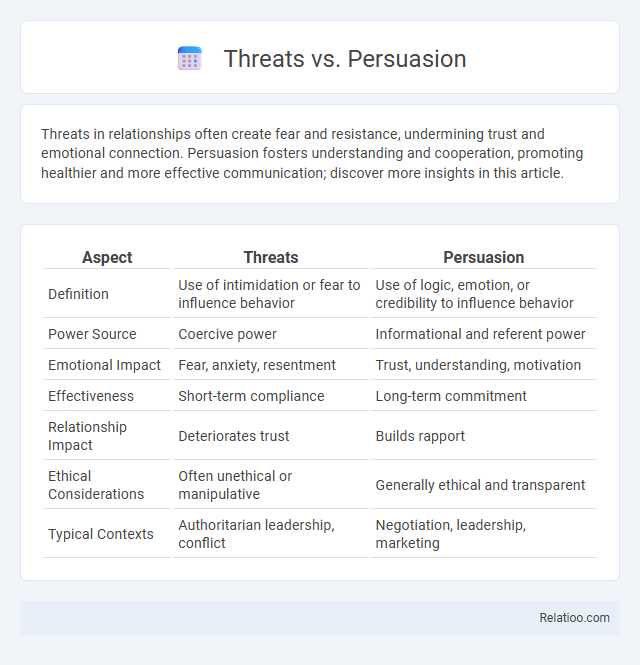Threats in relationships often create fear and resistance, undermining trust and emotional connection. Persuasion fosters understanding and cooperation, promoting healthier and more effective communication; discover more insights in this article.
Table of Comparison
| Aspect | Threats | Persuasion |
|---|---|---|
| Definition | Use of intimidation or fear to influence behavior | Use of logic, emotion, or credibility to influence behavior |
| Power Source | Coercive power | Informational and referent power |
| Emotional Impact | Fear, anxiety, resentment | Trust, understanding, motivation |
| Effectiveness | Short-term compliance | Long-term commitment |
| Relationship Impact | Deteriorates trust | Builds rapport |
| Ethical Considerations | Often unethical or manipulative | Generally ethical and transparent |
| Typical Contexts | Authoritarian leadership, conflict | Negotiation, leadership, marketing |
Understanding Threats and Persuasion
Understanding threats involves recognizing attempts to coerce or intimidate by implying negative consequences, while persuasion aims to influence attitudes or behaviors through reasoned arguments and emotional appeals. Your ability to distinguish between threats and persuasion is crucial for effective communication and decision-making. Grasping these differences enhances your skill in responding appropriately, ensuring you can protect your interests without escalating conflicts.
Defining Threats: What Constitutes a Threat?
A threat constitutes any communicated intent to cause harm, damage, or adverse consequences to an individual, group, or entity, creating a perception of imminent danger. In contrast to persuasion, which seeks voluntary compliance through reasoning or emotional appeal, a threat leverages fear and coercion to influence behavior. Understanding the nuances of what defines a threat is crucial for you to effectively distinguish between coercive tactics and genuine negotiation efforts.
The Psychology Behind Persuasion
Persuasion leverages psychological principles such as social proof, reciprocity, and cognitive biases to influence your attitudes and behaviors effectively without resorting to fear. Threats trigger defensive responses, often leading to resistance or compliance rooted in fear rather than genuine agreement. Understanding the psychology behind persuasion enables you to create compelling messages that motivate positive change through trust and empathy rather than intimidation.
Key Differences Between Threats and Persuasion
Threats involve coercion by imposing negative consequences to influence behavior, whereas persuasion relies on logical reasoning or emotional appeals to encourage voluntary compliance. Threats often evoke fear and resistance, reducing trust and cooperation, while persuasion fosters understanding and agreement through positive motivation. The key difference lies in the use of intimidation versus attraction to achieve behavioral change.
The Impact of Threats on Behavior and Decision-Making
Threats significantly influence behavior and decision-making by eliciting fear and urgency, which can override rational judgment and prompt immediate compliance or avoidance. The perception of a credible threat triggers neurological responses that prioritize survival, often leading to risk-averse or defensive behaviors. Understanding the psychological and physiological impact of threats is essential for designing effective communication strategies in negotiation, law enforcement, and behavioral interventions.
Persuasion Techniques in Communication
Persuasion techniques in communication leverage psychological principles such as reciprocity, social proof, and authority to influence attitudes and behavior without coercion. Unlike threats, which rely on fear and intimidation to induce compliance, effective persuasion fosters trust and engagement by appealing to emotions, logic, and credibility. Key strategies include storytelling, framing, and the use of positive reinforcement to create a compelling narrative that motivates voluntary action.
Ethical Implications: Threats vs. Persuasion
Threats manipulate individuals through fear of negative consequences, often violating ethical principles by undermining autonomy and consent. Persuasion relies on logical reasoning and appeals to values, respecting individual freedom and informed decision-making. Ethical considerations prioritize transparent communication and mutual respect, distinguishing persuasive strategies from coercive threats.
Real-World Examples: Threats and Persuasion in Action
Threats and persuasion differ significantly in approach and impact, with threats leveraging fear of negative consequences while persuasion appeals to logic and emotion for voluntary compliance. For instance, during the Cold War, the Cuban Missile Crisis exemplified threats through the U.S. and Soviet Union's nuclear posturing, contrasting with Gandhi's successful nonviolent movement in India that relied solely on persuasive tactics to achieve independence. These real-world scenarios underscore how threats can coerce immediate action under duress, whereas persuasion fosters lasting change by aligning interests and values.
How to Respond to Threats and Persuasive Attempts
Effectively responding to threats involves maintaining composure, assessing the credibility of the threat, and implementing de-escalation techniques such as active listening and clear boundary setting. In contrast, handling persuasive attempts requires recognizing the intent, evaluating the message for logical consistency, and responding with assertive communication that balances openness and skepticism. Adopting a strategic approach that differentiates between coercion and influence ensures appropriate reactions, safeguarding personal or organizational interests without escalating conflict.
Choosing the Right Approach: When to Persuade vs. When to Warn
Choosing between threat, persuasion, and warning depends on the desired outcome and audience perception. Persuasion effectively fosters trust and long-term behavioral change by appealing to logic and emotions, while threats may prompt immediate compliance but risk resistance or damage to relationships. Warnings serve as cautionary notices that balance urgency without coercion, proving essential when safety or legal consequences are implicated.

Infographic: Threats vs Persuasion
 relatioo.com
relatioo.com